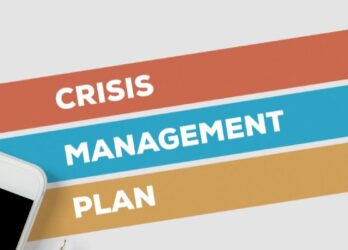Last updated on March 21, 2024 at 06:26 am
The pandemic taught us that a crisis can strike at any time, and we had better be prepared for it. But crises aren’t limited to something the scale of a global pandemic. Smaller crises happen all the time. A member of your C-Suite leaving, product recalls, severe weather, a large merger, layoffs—these are all crises that happen every day at organizations. We want to make sure that you are prepared with crisis strategies that work.
At theEMPLOYEEapp, we are experts at communicating with frontline teams. And like we saw with COVID-19, reaching our deskless workforce was a huge challenge if you didn’t have the right technology in place. But during a crisis, not being able to communicate can cost your business and potentially put your employees at risk. So, we’ll share our five crisis comms strategies for companies driven by frontline workers.
What Are Crisis Strategies?
Crisis strategies, also known as crisis management strategies or crisis response strategies, are pre-defined plans and actions that organizations put in place to effectively navigate and mitigate the impact of unexpected and challenging events. These events, often referred to as crises, can vary widely in nature, including natural disasters, public health emergencies, cyberattacks, organizational scandals, and more.
The primary goal of crisis strategies is to enable businesses to respond swiftly and decisively to avoid disrupting their operations and reputation. These strategies encompass various elements, including crisis communication plans, incident response protocols, risk assessments, and training programs.
In this blog, we’ll explore the importance of crisis strategies in supporting deskless workers during challenging times.
The Impact of Crisis on Deskless Workers
Deskless workers, including those in industries such as healthcare, logistics, manufacturing, and hospitality, are a vital part of the workforce. However, they often face unique challenges during crises that require additional support. Understanding the impact of crises on deskless workers is crucial for crafting effective crisis strategies.
Some key considerations include:
- Limited Access to Information: Deskless workers may not have regular access to company email or your employee intranet, making it challenging to receive timely updates and critical information during a crisis.
- Safety Concerns: Depending on their roles, deskless workers may be on the frontlines during emergencies, potentially facing health and safety risks. Effective crisis strategies should prioritize their well-being.
- Emotional Impact: The emotional toll of a crisis on deskless workers should not be underestimated. Addressing their mental health and well-being is essential for their resilience.
In the next section, we’ll explore five crisis strategies that you can use to better support your deskless workers during challenging times.
5 Crisis Strategies to Consider
These strategies can play a pivotal role in ensuring that deskless workers are well-informed, safe, and supported during crises. By prioritizing their needs and considering their unique circumstances, organizations can enhance their overall crisis management approach.
1. Help Your Frontline Managers
We already know that the role of the frontline manager is critical to retention, employee engagement, safety, and so much more. But during a crisis, they need a little more help than usual to share key messages and rally their teams.
You can help them by:
- Drafting clear talking points for their shift meetings/team huddles
- Creating a place where employees can share feedback and ask questions
- Recognizing them every chance you get
2. Keep the Lines of Communication Open
One great thing that came out of the pandemic was that leaders really got it. They saw the gaps in the lines of employee communication and that frontline workers didn’t really have direct channels for communication. They realized that they needed to step up (and get behind the camera). And IC pros began to adapt their crisis communication strategies to include more leadership messages.
Now is not the time to take your foot off the gas! Continue to encourage your leaders to keep up a regular cadence of messages to the frontline. And continue to innovate. Start a CEO coffee chat. Accept questions each week and then have your CEO do a rapid-fire answer session. And keep the recognition flowing from the top. One best practice that we saw our clients excel at was ensuring that their senior execs were consistently communicating and being as transparent as possible. Leading with humanity became a winning strategy, and that’s only going to continue in years to come. By making executive communications a habit now—and investing in channels that your frontline teams have access to—you set yourself up for success when a crisis strikes.
3. Take Your Internal Communication Strategy Mobile
If you haven’t already taken the leap to mobile, it’s time to seriously consider it. We encourage companies to have a variety of channels because diversifying your channel mix helps meet your employees where they are. And mobile is the most accessible channel for the frontline workforce.
And the reality is, as our personal lives become more mobile and agile, employees are going to expect the same technology at work. If you think your workforce won’t want a mobile comms app, think again:
- 8 in 10 digital minutes are spent on mobile. And 9 of 10 of those minutes are spent on apps (Marketing Charts).
- Currently, 74% of employees feel like they aren’t receiving important messages and information from their companies (Trade Press Service).
- Only 13% of employees report using their Intranet daily. 31% say they never do (Prescient Digital Media).
And our client Veterans United conducted exactly this kind of research before they made their decision to go mobile. They found:
- Smartphone ownership is only rising. 92% of people aged 30 – 49 and 96% of people aged 18 – 28 own a smartphone now.
- On average, smartphone users have 63 interactions on their phones a day.
- 50% of Americans own a tablet that can use apps.
4. Personalize Your Message
This isn’t just a marketing best practice to increase email open rates and conversions. Within a company, a targeted, personalized message is even more important.
We talk about employee engagement and how disengaged employees might just tune out messages. But it’s key to look at why that might be happening. Imagine you’re a nurse within a hospital system—you’re on the front lines and every day you are bombarded with crisis updates on top of the regular updates your hospital system sends out. Now imagine that you get the same email as every other frontline healthcare employee and you have to scroll down to the part for you—the messages for nurses. And now imagine that you don’t even have your own email address and you have to access that information on a shared computer.
Would you pay close enough attention? Would you always have time? And would you feel cared about, like your company understood the needs of your job?
And we dare to label these employees as disengaged. When really, when this happens, we have failed to meet our employees where they are.
But it’s not just about targeting. I think a lot of companies have realized that it’s important to separate out the messages to groups (e.g. doctors vs. nurses vs. non-clinical staff). But are those messages personalized? Are they coming from a place of understanding? Of empathy? Do you understand what their role demands? Do you know what that group of employees thinks, feels, and needs? Or do you address them just like anyone else?
Our crisis communication strategies require us to be better about listening to the needs of our employees and taking action accordingly.
5. Invest in Employee Listening
To accomplish the sometimes daunting task of personalizing your communications to employees, you’ll want to invest in employee listening strategies and technology.
Our Director of Client Success and Strategy Amy Jenkins said it best:
“Companies have always spent so much money on listening to customers and putting things out through marketing channels to get a sense of how people are feeling, what actions they’re taking. I’ve seen a shift over the course of the last year of organizations going, ‘what are employees thinking, feeling, doing, and how do I apply that to what we’re doing internally?’”
Amy Jenkins, Director of Client Success and Strategy, theEMPLOYEEapp
We need to continue to push this trend forward. It shouldn’t take a major crisis for companies to want to understand how their employees are, what they need, and what they think. Some of the best ideas can come when you open up to your frontline teams. We know that tapping into the employee voice helps IC pros tailor their messages and create content that truly resonates.
Next Steps for Preparing Your Crisis Strategies
Proactive crisis communication is an investment in your company’s resilience, employee wellbeing, and reputation. By planning your crisis strategies in advance, you make your business much more agile and able to withstand various crisis scenarios.
We are comms experts here at theEMPLOYEEapp. So, maybe we’re a bit biased, but we know that strong internal communication strategies that plan for crises make all the difference. To learn how we can help you improve your crisis communication, request a demo today.
Subscribe To The theEMPLOYEEapp Newsletter
Comments are closed.




